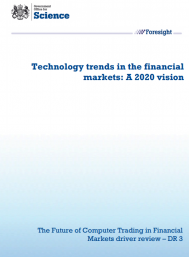
Foresight. Technology Trends in the Financial Markets: A 2020 Vision

Summary
The global financial markets have been aggressive early-adopters of new technologies for most of their history. In the past quarter of a century, since the instigation of the “Big Bang” switch to paperless electronic trading, the City of London has led the world in the adoption of new information and communications technology (ICT) for the provision of electronic trading facilities, and the associated distribution of data and news feeds. This hunger for new technologies looks unlikely to be diminished in future.
As well as many opportunities, ICT development has additionally brought risks (some of which are non obvious and even counter-intuitive) for which there is an immediate requirement for careful and thorough evaluation. New technologies may come in the form of new hardware, new software (including algorithms), or (most likely) combinations of the two.
As new technologies become available and more widely adopted, they may significantly alter what market actions and activities are possible, and in the longer term they may significantly alter the socio-economics of the financial markets, and hence also the necessary regulatory and political frameworks that financial institutions operate in.
In this document we establish the historical context for technology adoption in the financial markets, review current technology trends, and then extrapolate them out by five to ten years, in an attempt to identify what the financial-markets technology landscape might reasonably look like in 2020 or 2022. By identifying current products and services that appear to meet the technical definition of disruptive technologies, we explore what likely ICT developments over the next ten years will become the most significant to the financial markets, and how those developments might change the industry and affect the employment distribution of human traders. We then briefly speculate on the consequent possible impacts on systemic financial stability.
- Issues:
- Economics, Technological innovation
- Region:
- Global
- Year Published:
- 2011
- Authors:
- Dave Cliff, Dan Brown, Philip Treleaven
- Institutions:
- Government of the United Kingdom, Government Office for Science (UK)

